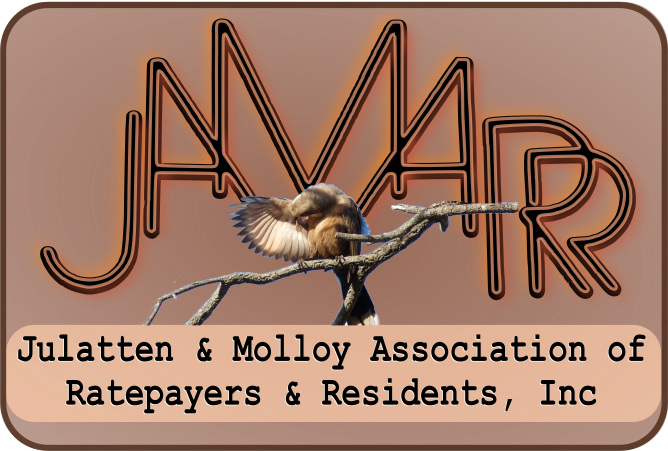Heritage Trail Planning Day
https://photos.app.goo.gl/7n8FG1VgfJqswZ2H2
A modest yet lively group assembled on Father’s Day morning in August to undertake the much-anticipated Heritage Trail Planning exercise.
The session was facilitated by Dr Wendy Seabrook, whose consultancy Learning from Nature, is focussed on low-input productive landscapes. Wendy led a brief introduction and orientation to how the day might unfold. The three stages of the design process involve:
- visualising what our goals and aspirations are for the site
- surveying and assessing the site
- combining these two frameworks into an advantageous mix of species and ecological functions
With introductions made and the theory in mind, we packed up our spades and headed off into the morning light.
The Spear Creek Bridge was our first stop. Nicknamed “The Gateway”, this area was seen as ideal for a bit of intensive care and maintenance. It forms a natural “portal” between the bushland walk and the village. There is already a beautiful little Leichhardt (Nauclea orientalis) sapling coming up. This would be an iconic specimen to support and nurture.
Around the corner from the Gateway is a soggy spot in the trail that reveals drainage from the eastern portion of the reserve toward the west, with a pretty little “pocket wetland” right off the trail. This was all obscured by Guinea grass, so Wendy demonstrated the technique of “assisted herbivoral regenerative trampling”. Essentially this involves using our big hiking boots to selectively stomp down the Guinea grass, revealing an impressive number of volunteer native trees pioneering their way toward dominance over the rank grasses.
Wendy points out that, especially in the late Wet, this technique will bring the crushed grass stems in contact with soil bacteria, accelerating the rot cycle, and providing a modest ring of compost around the young trees. It’s a simple technique and we all have a go. Surprising how much difference can be made after just 10 minutes of stomping around like a cow!
Further up the trail there is a line of large trees that could be coaxed toward the trail with a bit more “assisted trampling”. Once the trees establish sufficient cover they will shade out the rank grasses and slower-growing native shrubs will have a chance to re-establish. This stretch of the trail is punctuated by a large gum on the eastern side. Gerry Turpin, the Indigenous Ethnobotanist, demonstrated the qualities of Soap Tree (Alphitonia excelsa) to the delight of our group.
https://photos.app.goo.gl/he0nQ6JgGQAEGSBj1
A significant ravine runs up to the trail from the creek, and a small clearing has been established to look over the creek meanderings. We decide to call this area “Island View”. It would make a natural rest area. The question is how to provide some amenity without it becoming firewood or encouraging long-term camping.
From Island View it is possible to walk down into the creek area, and this is a magically-transforming experience. The ecosystem changes dramatically, the sounds of civilisation are in the muffled distance, and natural rustlings and chatterings take the centre stage. Although many people would appreciate this little walk, we’re not sure how to manage it without encouraging too much traffic. For now it will be an adventure waiting for the mildly observant to notice.
Continuing up the trail we reached the junction with the creek access road. This is a popular spot with local and tourists who enjoy being able to drive their 4wd vehicles down to the sandy banks of Rifle Creek and either camp or set up a little fire. As is so often the case, a few ill-mannered people spoil the amenity for everyone by leaving their rubbish lying about, cutting up the brush for firewood, and generally abusing an otherwise idyllic camping spot.
The road down to the creek provided a couple of excellent regeneration opportunities, with conditions very different to the main trail area. The groups exchanged ideas about how to tilt the natural cycle of forces toward regen with least possible effort. Clearing away some of the vines from the big trees was suggested as a starting point. Rupert Russell pointed out a very useful species already establishing itself.
It was agreed that the Junction would make a logical boundary for the Trail in the first phase. The short section onward to the campground will be easy enough to maintain and grow out once the main section has been established.
Back at the memorial Hall we tucked into a delicious tea and got out the markers and pens for a working session. Some of the main ideas were:
- to put stakes up to mark the naturally-regenerating trees
- to set bollard in to restrict vehicle access to the Trail
- to create some signage to let people know what the project is about
- to create some “gentle” directional signs asking people to treat the area with care and respect.
With the afternoon shadows growing long we reluctantly rolled up the plans and made a couple of ongoing commitments. The most exciting of these was to launch a new “social group” whose main activity would be to visit the various Molloy/Julatten planting areas to (a) stomp around like cows and (b) put on genteel picnics in agreeable locations. A couple of names for the group were suggested, but we’ll leave that matter open for wider public contribution!
